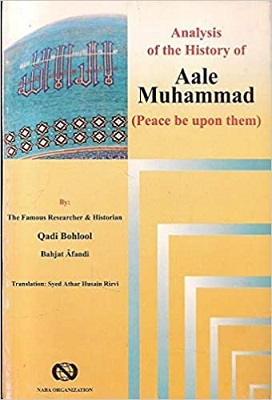Analysis of the History of Aale Muhammad
 | |
| Author | Qadi Bohlool Afandi |
|---|---|
| Language | English |
| Published | 2013 |
| Publisher | CreateSpace Independent Publishing Platform |
| Pages | 134 |
The book Analysis of the History of Aale Muhammad helps us to know the conditions and the history of events connected with pious household of Prophet Muhammad.
About the author
Qadi Bohlool Bahjat Afandi was well versed in rational and traditional sciences as also gnosis (irfan). He was distinguished in numerous qualities and accomplished in many arts. He was very religious. He was a follower of the Hanafi School. In jurisprudence, he followed Abu Hanifah. At last he gave up the Hanafi School and began to follow the Shafei Maslak, which he continued for the rest of his life. He was good-natured, honest, brave, humorous and broad faced. He was a handsome personality with a sweet tongue and corpulence. He was born in 1288 A.H. in the city of Zangizur. According to authentic sources, he passed away in 1350 A.H. However, some people maintain that he was murdered. He has left three sons and a daughter named, Bahauddin, Abdullah, Ali Jamaluddin and Fatemah.
About the book
This book written by Qadi Bohlool Bahjat Afandi and translated into English by Seyed Athar Hussain Rizvi was published in CreateSpace Independent Publishing Platform (December 1, 2013). It has 134 pages, and tries to enlighten the minds of the coming generations. The author of the present book does not want to leave the readers groping in the darkness of superstitions, confused!
Abstract of chapters
Introduction
In this part the author considering the blunders of Tabari and the rest of historians, tries to present some historical evidences so that it may be known that the history of the Progeny of the Holy Prophet has been neglected to a great extent. He makes it clear that to what extent the rights of the Holy Progeny were being trampled upon.
Legatee of the Messenger of Allah
After the holy Prophet, Ali was the most knowledgeable personality. There was none his equal among all the people. In this way, Hazrat Amirul Momineen was the most superior person in the Ummah. The author in this chapter discusses the causes and signs of Ali’s superiority because superiority is a quality that is established by its signs and causes. He brings the traditions of the Holy Prophet that announce the superiority of Ali over all the people. (Hadith-e-Ghadeer: Tradition of Ghadeer-e-Khumm). After that he explains Hadith-e-Tayr: The Tradition of the Bird, that the majority of Muslims have accepted its reliability, and for the sake of clarity, he provides some important conclusion derived from that. And at the end, he considers Hadith Madinatul Ilm: Tradition of the City of Knowledge.
The Problem of Caliphate
The author dedicates the first part of this chapter to the discuss about the origin of caliphate. Then begins the discussion of Umayyads. After that, he studies the period of Bani Abbas that was a period of great Islamic scholarship and jurisprudence. In his belief, it should have been a period of expounding of the realities but what a pity! It proved to be worst for the Muslim Ummah wherein the worst types of evils and crimes were perpetrated. At the end of this chapter he starts the discussion of the nomination and selection of the second caliph.
Terrible Consequences
The superiority and caliphate of Ali bin Abi Talib was an established matter that caused adverse consequences. When the Holy Prophet expired, while Ali bin Abi Talib was busy with the funeral arrangements, the event of Saqifah Bani Saaedah occurred and Caliphate was transferred to Abu Bakr, even though all the companions were aware of its adverse effects in the future. Here the author only mentions the most authentic narration of the Ahle Sunnat.
FATIMA ZAHRA
The holy Prophet had no attachment with anything. Only Fatima Zahra, the leader of all women, was extremely dear to him. So it is essential that Fatima must be dearer than life for every professing believer because the holy Prophet has said. The author in this chapter, intends to explain and examine the event of Fadak and express his view regarding this bitter and retrograde happening.
* Fadak is one of the properties, which belonged to the Jews who lived around Madinah. After the conquest of Khaibar, as per the terms of treaty, it went in the possession of the holy Prophet.
Conclusions
The author concludes that for the issue of succession, a capable person should be identified and selected to acquire the post. Obviously, the one whom the Holy Prophet has selected and the one, who has been identified with distinct signs of infallibility by the Holy Prophet, will of course, be a guaranteed selection and the best choice.